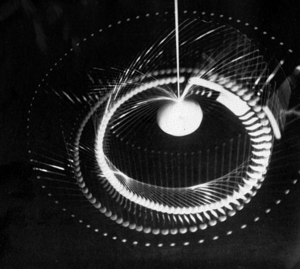|
overview
+ development
explanation
images
radial images
quicktime movies:
5.6
MB | 9.3
MB
|
Technology
has long been used to augment vision. The innovation of the telescope
in the early 17th century by Galileo is an early example. After the
development of the camera in the mid 19th century, many artists began
using its potential to 'stop' time and analyze details of movement that
had never been visible to the human eye. In the 1930s, Harold Edgerton
pioneered the process of stroboscopic photography which enabled capturing
the successive movements of an object with a still camera. Utilizing
this technique, the photographs of Herbert Matter and L. Moholy-Nagy
began to reveal a new vision, a sight unbound from time.
 |
|

Herbert Matter
Calder
in Motion, 1939
|
Digital
computation has provided a medium for further extending our vision.
Some of the experiments of John Maeda reveal this in an eloquent way.
In his experimental Parametervision, every possible image constructed
by a two dimensional parametric system can be viewed in a single image
plane.
 |
|
John
Maeda
Parametervison,
1999
|
Plane
Modulator combines both innovations into a system for constructing a
new vision. It augments the early experiments in time and motion by
providing the tools for analysis made possible through computation.
|



